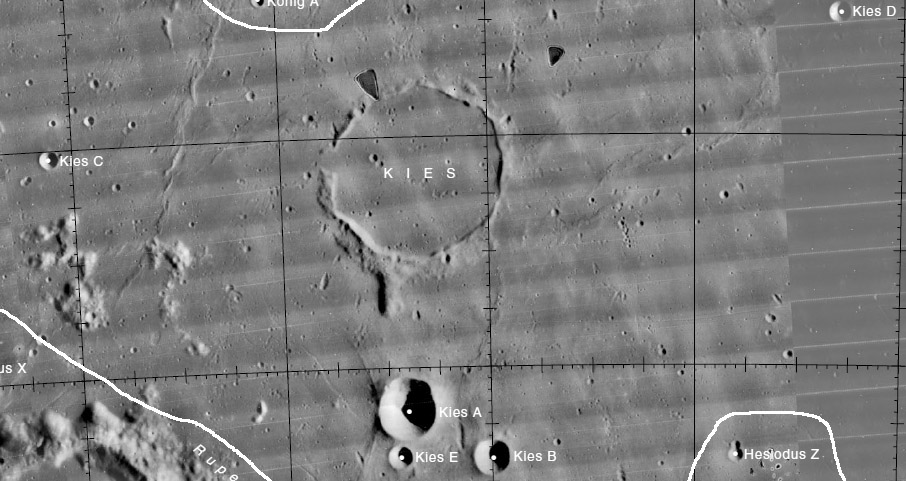Kies
Contents
Kies - and Lenham (Kies A) south of it
Lat: 26.3°S, Long: 22.5°W, Diam: 45 km, Depth: 0.39 km, Rükl: 53
Middle: LO-IV-125H (the dark triangular marks are flaws in the on-board film development).
Right: Rainer Ehlert (note the dome Kies Pi west-southwest of Kies, and also the cluster of hills unofficially known as the Golubiz cluster).
Images
LPOD Photo Gallery Lunar Orbiter Images Apollo Images
Maps
(LAC zone 94D2) LAC map Geologic map
Description
Description: Elger
(IAU Directions) KIES.--A somewhat similar formation, S. of Bullialdus, about 25 miles in diameter, also encircled by a border of insignificant dimensions, attaining an altitude of 2,400 feet at only one point on the S.W., while elsewhere it is scarcely higher than that of Lubiniezky. It is clearly polygonal, approximating to the hexagonal type. On the more distinct S. section a bright spur projects from it. On the N. its continuity is broken by a distinct little crater. It is traversed by a remarkable white streak, extending in a S.E. direction from Bullialdus C (where it is very wide), across the interior, to the more easterly of two craters S.E. of Mercator. Another streak branches out from it near the centre of the floor, and runs to the E. wall. The principal streak, so far as the portion within Kies is concerned, represents a cleft. On the Mare W. of Kies is a curious circular mound, and farther towards Campanus two prominent little mountains. On the N.E. is a large obscure ring and a wide shallow valley bordered by ridges.
Description: Wikipedia
Additional Information
Depth data from Kurt Fisher database
- Arthur, 1974: 0.39 km
- Westfall, 2000: 0.39 km
- Viscardy, 1985: 0.38 km
- From the shadows in LO-IV-125H, the highest point on the east rim of Kies is about 370 m above the floor. The “handle” on the south is up to 600 m tall. - JimMosher
- Satellite crater Kies A is on the ALPO list of banded craters
- The officially unnamed pair of craterlets at the northwestern part of Kies's floor is an excellent test-object for those who want to know if their telescope is of good quality.- DannyCaes Dec 8, 2008
- The bright bowl-shaped crater Kies A (Wilkins's Lenham) shows a curious clair-obscur effect at the shadow of its western rim, a couple of hours after local sunrise. Kies A's shadow looks "interrupted" at its central part. This "interruption" is caused by a curious wing-like formation at the crater's western rim. Two wing-like appendages run north-northwest and south-southwest, radiating out of the crater's western rim. A similar formation is noticeable at crater Cauchy in Mare Tranquillitatis. The "wings" at Kies A's western rim are also noticeable in the LPOD of 2-5-2009; near the photograph's upper left corner. Research: Danny Caes.
- Paolo Lazzarotti's photo of the Kies and Kies A region (made after local sunrise) shows the curious "interrupted" appearance of Kies A's western shadow very well! Research: Danny Caes.
Nomenclature
- Named for Johann Kies (September 14, 1713—July 29, 1781), a German astronomer and mathematician. Kies worked to make observations on the lunar parallax. Kies wrote, "Observations on eclipses are extremely useful, especially the ones that are exact." Kies was one of the first to propagate Newton's discoveries in Germany, and dedicated two of his works to the Englishman.
- According to Whitaker (p. 218), this name was introduced by Schröter.
- Kies Beta (the southern "appendix" of Kies).
- Kies Epsilon (hillock southwest of Kies, west of Kies A).
- Kies Pi (among many observers of the moon, crater Kies is known for the dome Kies Pi west-southwest of it, this dome is one of the most popular lunar surface formations which received a Greek letter designation, unfortunately not recognized by the International Astronomical Union) (why?).
- Kies A, a bowl-shaped crater south of Kies itself, was called Lenham by Hugh Percy Wilkins and Patrick Moore, but the I.A.U. did not accept that name.
- Lenham: contemporary English selenographer.
- The group of hillocks between Kies and Campanus (west-southwest of Kies) is unofficially called Golubiz cluster (this name was printed on the greenish colored Rand McNally moonmap). The origin of it (the name Golubiz) is still unknown.- DannyCaes Aug 23, 2008
Lettered Craters

Excerpt from the USGS Digital Atlas of the Moon.
LPOD Articles
A Hole in the Wall
Horns and Wings (Lambert Spix's drawing of the sunrise shadowspires at Kies A; aka Wilkins's Lenham)
Lunar 100
L60: Volcanic dome.
Bibliography
- Kies A ("Lenham"): THE MOON by H.P.Wilkins and P.Moore.
- Kies and Kies A: A Portfolio of Lunar Drawings (Harold Hill), pages 110, 111.


